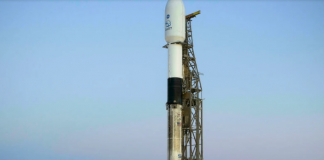By AFP

NASA is preparing to launch a mission to deliberately smash a spacecraft into an asteroid. The test will help determine whether NASA is capable of deflecting an asteroid should humanity ever need to stop a giant space rock from wiping out life on Earth.
It may sound like the stuff of science fiction, but the DART (Double Asteroid Redirection Test) is a real proof-of-concept experiment, blasting off at 10:21 pm Pacific Time Tuesday (0621 GMT Wednesday) aboard a SpaceX rocket from Vandenberg Space Force Base in California.
Its target object: Dimorphos, a “moonlet” around 525 feet (160 meters, or two Statues of Liberty) wide, circling a much larger asteroid called Didymos (2,500 feet or 780 meters in diameter), which together orbit the Sun.
Impact should take place in the fall of 2022 when the pair of rocks are 6.8 million miles (11 million kilometers) from Earth, the nearest point they ever get.
“What we’re trying to learn is how to deflect a threat,” said NASA’s top scientist Thomas Zuburchen in a press call, of the 330 million U.S. dollar project, the first of its kind.
NASA’s Planetary Defense Coordination Office is most interested in those larger than 460 feet (140 meters) in size, which have the potential to level entire cities or regions with many times the energy of average nuclear bombs.
There are 10,000 known near-Earth asteroids 460 feet in size or greater, but none has a significant chance to hit in the next 100 years. One major caveat: only about 40 percent of those asteroids have been found to date.
Planetary scientists can create miniature impacts in labs and use the results to create sophisticated models about how to divert an asteroid but models rely on imperfect assumptions, which is why they want to carry out a real-world test.
The DART probe, which is a box the size of a large fridge with limousine-sized solar panels on either side, will slam into Dimorphos at just over 15,000 miles an hour (24,000 kilometers per hour), causing a small change in the asteroid’s motion.
Scientists say the pair are an “ideal natural laboratory” for the test, because Earth-based telescopes can easily measure the brightness variation of the Didymos-Dimorphos system and judge the time it takes Dimorphos to orbit its big brother.
Their orbit never intersects our planet, providing a safe way to measure the effect of the impact, scheduled to occur between September 26 and October 1, 2022.
Andy Rivkin, DART investigation team lead, said that the current orbital period is 11 hours and 55 minutes, and the team expects the kick will shave around 10 minutes off Dimorphos’ orbit.
There is some uncertainty about how much energy will be transferred by the impact because the moonlet’s internal composition and porosity isn’t known.
The more debris that’s generated, the more push will be imparted on Dimorphos.
“Every time we show up at an asteroid, we find stuff we don’t expect,” said Rivkin.
The DART spacecraft also contains sophisticated instruments for navigation and imaging, including the Italian Space Agency’s Light Italian CubeSat for Imaging of Asteroids (LICIACube) to watch the crash and its after-effects.
The trajectory of Didymos could also be slightly affected, but it would not significantly alter its course or unintentionally imperil Earth, scientists say.

